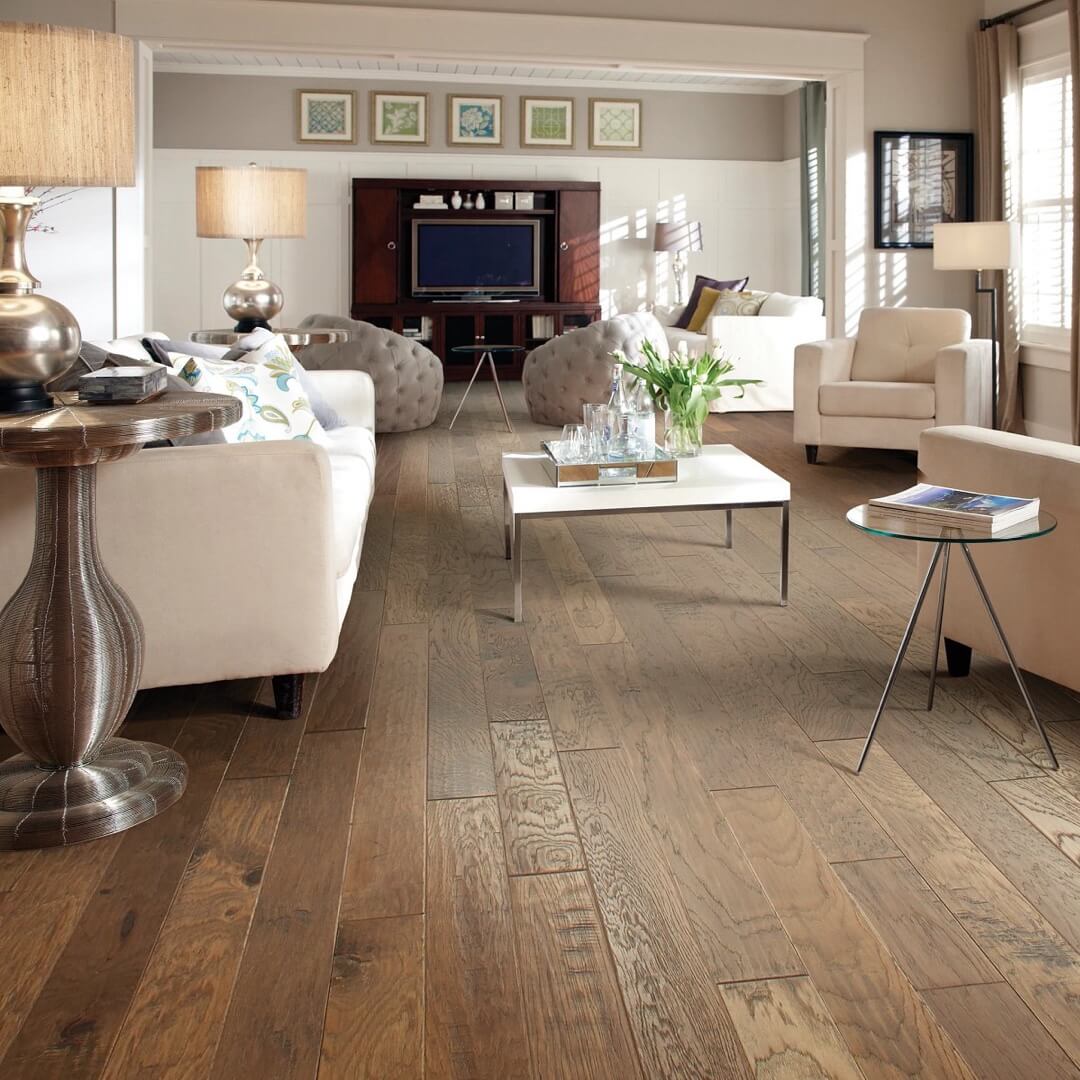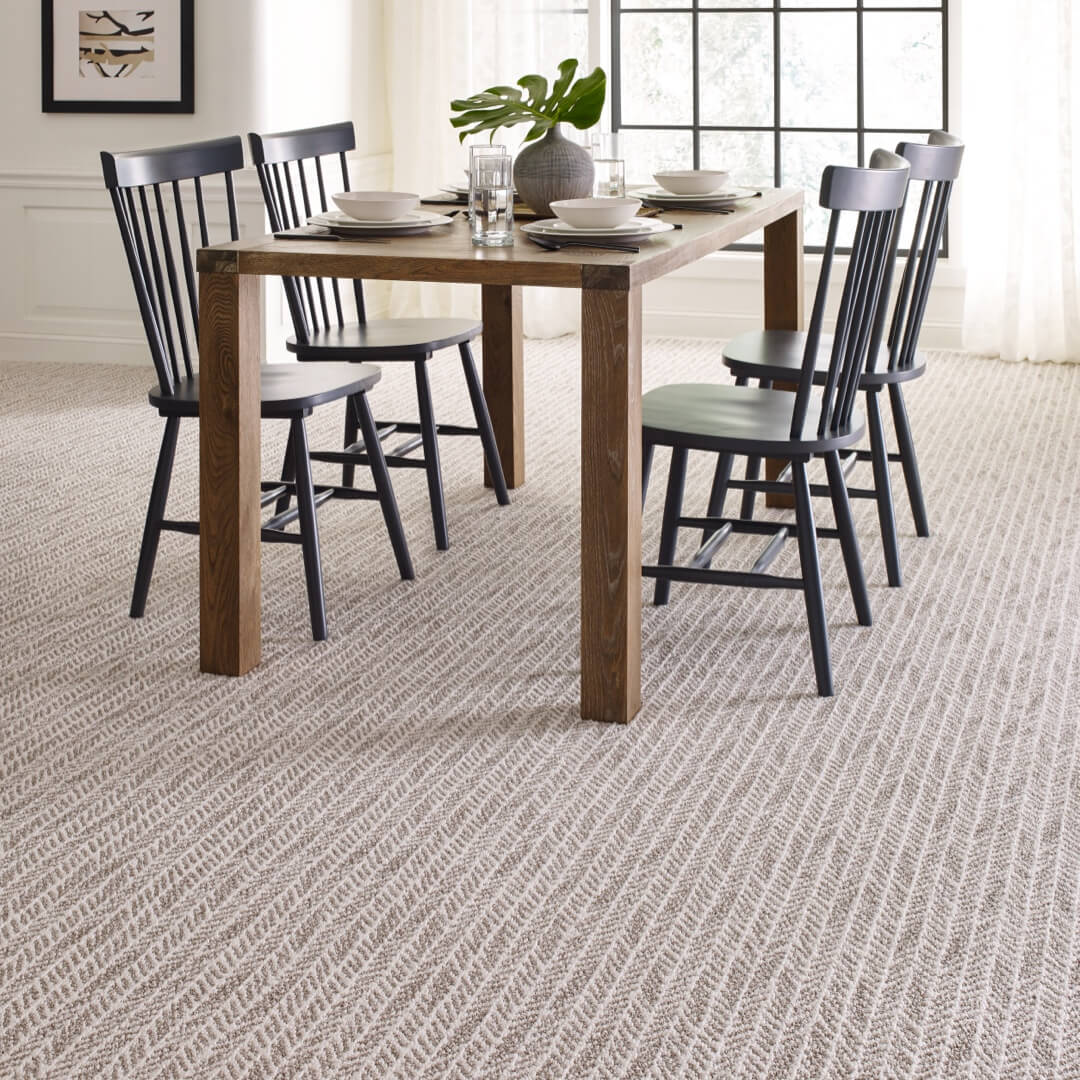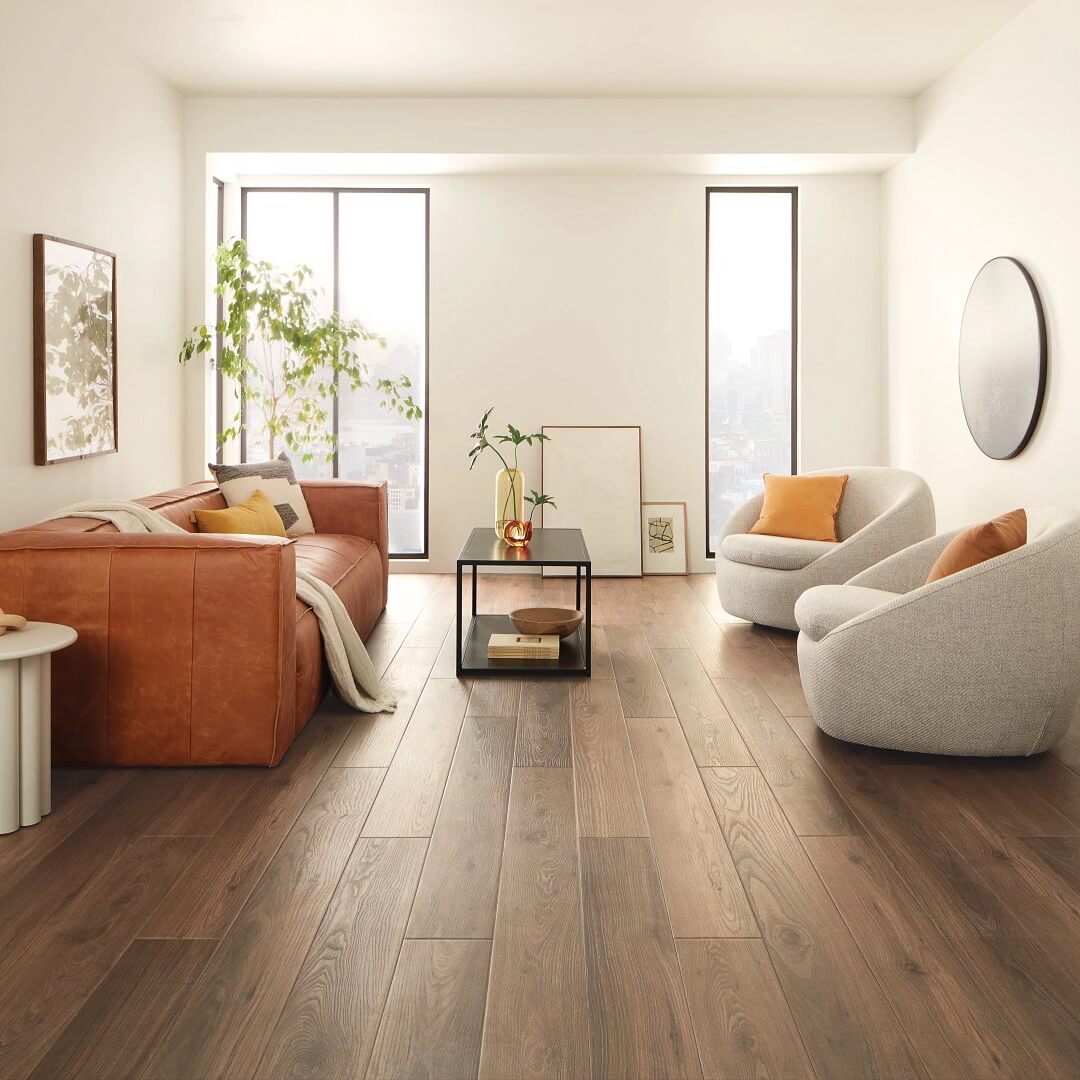Creating Harmony with Flooring Texture
Flooring decisions involve more than material and color.
Texture plays a key role in how your home looks, feels, and functions. From the soft comfort of carpet to the organic character of wood grain or stone variation, texture helps shape a room’s mood and style.

Whether you’re installing hardwood in a living room or tile in a bathroom, texture adds depth and visual interest. And when thoughtfully coordinated across your home, it supports a sense of flow, connecting one space to the next with a consistent, balanced feel.
Why Flooring Texture Is Important
Texture influences far more than appearance. It affects how a surface feels underfoot, how warm or cool a room seems, and even how sound and light behave. In open layouts, it can help define distinct areas without creating harsh visual breaks, adding both character and function.
The benefits of texture include:
- Helps mask everyday wear by minimizing the appearance of dust, footprints, and surface imperfections.
- Improves traction in moisture-prone areas like kitchens, bathrooms, or entryways.
- Supports layered design by working in tandem with furniture, textiles, and lighting to create a cohesive look.
- Enhances realism in manufactured materials like luxury vinyl or laminate by mimicking the tactile qualities of natural stone or hardwood.
Understanding Different Flooring Textures
Every flooring type brings a unique texture, contributing to its look, feel, and performance. From subtle grain patterns to bold stone finishes, texture can highlight natural materials or elevate manufactured ones with added realism. Today’s options make it easier than ever to choose textures that align with your lifestyle while complementing your home’s design.
Luxury Vinyl (LVP & LVT)
Luxury vinyl is known for its ability to replicate the texture of natural materials. Whether you prefer the warm grain of wood or the raw edge of stone, surface embossing plays a key role in how realistic and practical these floors feel in everyday use.
Texture options include:
- Embossed wood grain: This texture follows the printed wood pattern beneath, giving the surface a realistic, tactile feel. It’s ideal for traditional or transitional spaces where you want the look and texture of hardwood with added durability.
- Stone-textured vinyl: Designed to mimic the surface of slate, travertine, or concrete, this finish introduces natural variation and a slightly weathered touch that’s well suited for bathrooms, entryways, or contemporary kitchens.
- Low-sheen finishes: These smooth, matte surfaces minimize glare while offering a subtle texture underfoot. They work well in open floor plans or homes with lots of natural light.
- Textured wear layers: Slightly raised surfaces add gentle grip without being rough. This makes them a practical choice for households with children or aging adults where slip resistance is a priority.
Hardwood
Hardwood flooring brings natural texture through its grain patterns, but its surface treatment influences how that texture feels and looks. The same species can take on a rustic or contemporary tone depending on the finish.
Texture options include:
- Smooth finish: Sanded to a soft, even surface, this style lends a clean, refined look that fits well in formal dining rooms, bedrooms, or traditional interiors.
- Wire-brushed: Subtly textured to highlight the grain, wire-brushed hardwood balances visual interest with a muted, lived-in feel. It’s popular in coastal, transitional, or casual homes.
- Distressed or hand-scraped: These finishes replicate the natural wear of aged wood, adding character and texture underfoot. They pair well with rustic, farmhouse, or industrial designs.
- Open grain patterns: Naturally varied textures—ranging from tight lines to flowing movement—bring personality to each plank. This variation works especially well in eclectic or organic design schemes.
Tile & Natural Stone
With tile and stone, surface texture affects both style and function. Finish choices impact light reflection, traction, and even how warm or cool a room feels, making it important in both aesthetic and practical terms.
Texture options include:
- Glossy finish: Smooth and highly reflective, a glossy tile surface enhances light and adds a polished look to bathrooms, backsplashes, or smaller rooms that benefit from brightness.
- Matte tile: With a flat, soft surface that doesn’t reflect as much light, matte tile offers a grounded, contemporary feel. It’s well suited for larger floors or minimalist interiors.
- Cleft stone: This rough, uneven texture showcases the natural split of materials like slate, adding strong visual character. It’s a bold choice for entryways or accent floors.
- Honed or tumbled: These finishes soften the edges and surface of stone for a slightly worn, velvety feel. They’re ideal for wet areas where both slip resistance and warmth are important.
Carpet
Carpet texture directly affects both performance and comfort. From low, durable loops to thick, luxurious pile, texture determines how a room feels underfoot and how sound behaves throughout the space.
Texture options include:
- Plush pile: Dense and velvety to the touch, plush carpet creates a smooth, elegant finish that’s perfect for bedrooms or quiet sitting areas where softness is a priority.
- Berber (looped): Made from tight, continuous loops, Berber carpet resists crushing and wears well over time, making it a smart choice for stairs, playrooms, or hallways.
- Frieze (twist): Featuring long, twisted fibers, this style offers a casual, textured look that hides footprints and works well in high-traffic areas.
- Cut-and-loop: This blend of cut and looped fibers forms subtle patterns and adds dimension. It’s a great way to introduce interest and softness to living rooms or stairs.

Laminate
Laminate mimics the look of wood using a printed image layer. The surface texture helps sell the illusion, adding depth and improving performance in high-use areas.
Texture options include:
- Embossed wood grain: Raised to match the image layer, this texture gives laminate a more realistic feel. It’s a durable and stylish option for living rooms, bedrooms, or offices.
- Low-gloss finish: With a smooth, muted appearance, this finish reduces glare and hides daily wear. It’s especially effective in open spaces with heavy use.
- Embossed-in-register: This advanced finish aligns texture with the printed design for added realism. It’s ideal for homeowners who want the most authentic-looking laminate available.
Area Rugs
Rugs are a flexible way to add texture, especially over hard flooring. They help soften sound, create zones, and bring depth to a room whether through material, weave, or pile height.
Texture options include:
- Flat-woven: Tightly woven with little to no pile, flat-woven rugs provide a clean texture and casual look. They’re well suited for kitchens, under dining tables, or layered over larger rugs.
- Plush pile: Soft and cushioned underfoot, plush rugs bring warmth and comfort to bedrooms or lounge areas where you want to create a cozy atmosphere.
- Shag or high-low: Featuring varying pile heights, these rugs introduce movement and softness. They’re a great way to add interest to minimalist or monochromatic spaces.
- Patterned textures: Carved or looped designs create visual breaks across large floor spaces. They help define areas and add subtle complexity without overwhelming the room.
How to Combine Textured Flooring in Your Home
When working with multiple flooring materials, texture becomes a powerful design tool. Thoughtful combinations can tie a space together, define different zones, and create a more comfortable, cohesive home. The goal is to strike the right balance, matching textures to function, style, and flow.
- Complement Hard and Soft Surfaces: Pairing a plush rug with hardwood or vinyl can soften the room both visually and acoustically, making shared spaces more welcoming and functional.
- Use Texture to Define Zones: In open layouts, transitioning from tile to wood or adding carpet in a designated nook helps signal how each space is used without breaking up the overall design.
- Plan Seamless Transitions: Choosing flooring textures with similar tones or grain patterns, especially where surfaces meet, keeps the eye moving smoothly from one space to the next.
- Layer with Purposeful Rugs: Rugs add comfort and dimension while helping anchor furniture groupings. Look for textures that contrast with the floor beneath, like high-pile rugs over matte tile or woven rugs on smooth wood.
- Balance Texture with Practical Needs: Durable textures like wire-brushed wood or looped carpet handle high-traffic areas well, while slip-resistant tile textures add safety in bathrooms and entryways.

A Unified Look Through Thoughtful Texture
Texture plays a powerful role in how your home looks, feels, and functions. It influences comfort, defines space, and brings personality to every surface. When your flooring choices are guided by texture—as well as color, material, and layout—your home feels more connected and complete.
If you’re planning a remodel or updating a single room, we can help you make informed choices that support both your style and your lifestyle.
Visit Carpetland USA of Virginia in Roanoke, Christiansburg & Martinsville, VA to explore flooring textures that bring warmth, character, and long-lasting comfort to your home.
